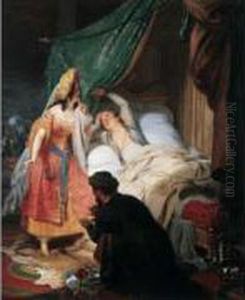Antoon Van Ysendyck Paintings
Antoon Van Ysendyck was a Belgian architect born in 1841, notable for his contributions to the field of architecture during the 19th century. His work, primarily situated in Belgium, exhibits the eclectic and revivalist styles that were popular in Europe during his time. Van Ysendyck's architectural legacy is characterized by a mix of neo-Gothic, neo-Renaissance, and other historical styles, reflecting the diverse influences and the historicist approach prevalent among architects of his era.
After completing his education, Van Ysendyck went on to design and supervise the construction of numerous buildings, including public buildings, churches, and private residences. His designs often incorporated modern construction techniques and materials, while at the same time, paying homage to the past through the use of historical architectural elements. This duality not only made his work popular but also contributed to the architectural heritage of Belgium, leaving a lasting impression on the country's urban and rural landscapes.
Despite his contributions to architecture, Antoon Van Ysendyck is not as widely recognized internationally as some of his contemporaries. However, within Belgium and amongst scholars of 19th-century European architecture, his work is appreciated for its quality and for the role it played in the development of modern Belgian architecture. Van Ysendyck's commitment to the revival of historical styles, combined with his adaptation of new technologies and materials, makes his work a significant area of study for those interested in the evolution of architectural practice.
Antoon Van Ysendyck's career was cut short by his untimely death in 1894. However, the buildings he designed remain as testaments to his skill and vision. Through his architectural achievements, Van Ysendyck contributed to the cultural and historical tapestry of Belgium, making him an important figure in the country's architectural history. His legacy continues to be studied and celebrated for its contribution to the architectural heritage of Belgium and the broader narrative of 19th-century European architecture.

